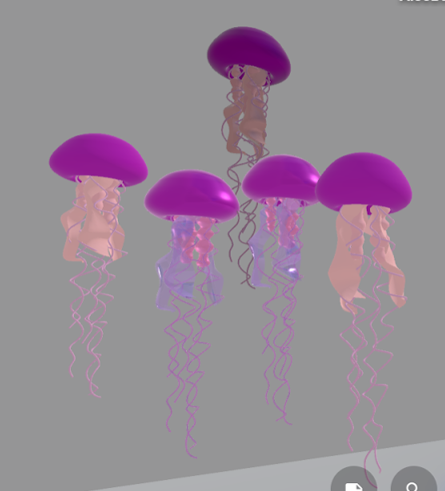AQUA WORLD: AN INTERACTIVE VR AQUARIUM
Aqua World is an experimental abstract underwater environment. This project was developed during my 2022 summer residency at the University of Toronto's Dynamic Graphics Project lab. It is a 3D Modeling, 3D Animation, and Virtual reality project. The 3D models were made and hand-keyframed using a combination of Maya and Gravity Sketch. The materials were created in Blender.
1 - CONCEPTUALIZATION
The natural world is incredibly beautiful; the Earth's oceans house a variety of fascinating sea creatures and marine formations. After growing up near the beach and taking Marine Science in high school, I developed a strong appreciation for marine life and wanted to find a way to transmit that in a 3D project. A visit to Ripley’s Aquarium in Toronto had me wondering about the logistics of creating a virtual aquarium. I didn’t want to make it a traditional aquarium: I wanted it to break and bend physics in such a way that only 3D worlds can handle. My goal was to merge elements of the real aquatic world with completely make-believe organisms that followed the laws of oceanic structures. The space itself would be one that visitors could walk through. Moreover, I wanted it to be a place where the visitors could interact with each other, and meet virtually. This is why I chose to host my project on Spatial.io--it allowed me to focus on the 3D modeling and 3D animating side of things while the platform itself took care of the back-end.
MOODBOARD:

2 - 3D MODELING
After deciding the artistic style of my aquatic world—rounded shapes, repeating patterns, and squishy substances—I proceeded to model my objects using a combination of Gravity Sketch and Maya. Designing these structures proved challenging; it required modeling objects in a structural way using patterns and repetition, but the models still had to look organic. Therefore, I designed the jelly substances, trees, and jellyfish in Gravity Sketch, which enabled me to make very organic and circular motions with imperfections that are more natural to living creatures. The more structured organisms, such as the anemone and corals, I modeled in Maya.



All throughout the modeling process, I kept in mind real coral-reef structures. The point was to reimagine them in an abstract way while still staying true to the visual complexity of these oceanic beings.


My initial idea was to create a large building with hexagonal sections that would house one specific aquatic creature.



However, I scrapped that idea and decided instead to make an open-world style map. I modeled a platform with no walls that the user can walk on, giving the impression that they are viewing a small portion of an infinite space.
3 - ANIMATION
Animating the objects proved to be one of the most tedious parts of this project. I imported all of the models into Maya and hand-keyframed the movements and transformations. To make the environment seem more natural, I offset the jellyfish animations and keyframed them to transform in different sequences. There are nine total jellyfish in the Aqua World environment. The same I did for the anemone.


4 - MATERIALS/TEXTURING
In order to upload this project into Spatial.io, I had to work with .GLTF files. Blender is one of the only 3D software that currently exports .glb or .gltf files, so I baked the animations in Maya and imported them as FBX files into Blender, where I created the materials and added the necessary textures to my models. The jellyfish required the most attention out of all the models. I made many versions and imported them into Spatial.io to see how the materials looked. The same is true for all of the other models in Aqua World.

CONCLUSION
Designing and building Aqua World from scratch taught me a variety of useful skills:
1) Blender: I had previously used Blender for only small projects. Most of my models and animations have been made with Maya.
2) 3D modeling organic items with purposeful imperfections: this was an essential part of Aqua World. If the models looked too clean and precise, they would've looked too much like plastic toys.
3) Project management for long-term projects: I was responsible for a much larger-scale project than what I usually did, so I learned to use project-management techniques to make sure I was turning in my deliverables on time.
4) Working with a team: during my experience at the University of Toronto, I had the opportunity to work with several Computer Science PhD students on their projects. This required lots of coordination, process documentation, and pipeline optimization so that the multiple parties could work together at once.
The most beautiful moment I will take with me from the whole project development experience was when I presented my finished project to the DGP lab. Seeing my labmates visiting Aqua World in VR and being excited to see each other inside that space was so fulfilling. When they talked about how beautiful the marine world is and how I had done well in capturing that in a fantastical way was the moment when I knew my goal had been accomplished.